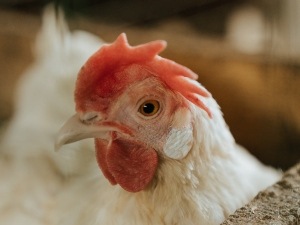
Abscesses can be painful on humans and on chickens as well, these growths aren’t normal and you’d likely visit your doctor if you had one. You may be wondering why your chicken has one and what to do, this article looks into it.
An abscess on your chicken’s face can be caused by an accidental or intentional injury. An abscess forms when bacteria get into a wound. You can lance the abscess off to get rid of it
Table of Contents
Chicken has an abscess on its face
A sudden growth on your chicken’s face can be concerning, growths on your bird’s face can be abscesses or something more sinister. The article below will help you figure out why this happens and what to do
Why this happens
Humans develop abscesses as a result of bacterial infections, the same happens with chickens.
If your bird gets injured through pecking, stepping on something, or is injured in some other way, their skin will develop a wound that can become infected.
If bacteria enter the chicken’s body through the wound, the bird’s body will send white blood cells to the affected area.
The bacteria and white blood cells will attack each other, this can cause nearby tissue to die. This dead tissue fills with pus-forming an abscess. Pus is a mixture of bacteria, white blood cells, and dead tissue.
How to get rid of an abscess on a chicken
You’d need to make sure that the lump on your bird’s face is in fact an abscess and not something else. The lump may be an insect bite, a tumor (benign (non-cancer-causing) or malignant (cancer-causing)) or it may be the result of a respiratory infection.
Figuring out what it is is essential before draining it. An abscess is painful to the touch, your bird will not like you touching it, it will also be warm to the touch. You’d need to aspirate the abscess to be sure
How to aspirate an abscess:
Before doing anything you need to protect yourself. Make sure that you wear PPE before aspirating the bird’s abscess. PPE includes a mask, safety glasses, and gloves
Once you have your PPE on, slowly and gently insert a sterile needle into the swelling of the abscess, insert it into the thinnest part of the skin.
A ripe abscess will have a thin-skinned part that moves easily under pressure just as a blister would. If pus comes out, you can be sure that this is an abscess.
If the bump is an abscess, you can lance and drain it.
How to lance and drain the abscess:
After aspirating, clean the bird’s skin using a topical disinfectant. Proceed to sterilize the blade that you’ll be using to lance the abscess.
Lance the abscess at the ripest part where the skin is the thinnest. Make a cross-shaped incision on the abscess.
Making a cross is better than making one cut because a single cut will close faster than a cross-cut making draining difficult. In addition, a single cut won’t drain as well.
Press on the sides of the abscess and allow it to drain onto a paper towel, plastic bag, or anything that can be incinerated after this process.
Sterilize the wound site by flushing it with sterile water, Dakins solution, or a topical disinfectant. Apply Neosporin on the wound and treat the bird with antibiotics afterward if needed
Note:
If the abscess on your chicken’s face is particularly deep then it would be best to visit your vet with your chicken rather than lancing it yourself.
If only one chicken develops an abscess on its face then you won’t have to worry, you can simply lance the abscess.
If a number of your chickens are suddenly growing abscesses then you should consult a vet, you can give the vet samples of the contents of the abscess to assess.
FAQ:
Why is my chicken’s face swollen?
If your chicken’s face is swollen then this may mean that the bird is suffering from a condition called infectious coryza.
Infectious coryza is a respiratory infection that causes facial swelling. It also causes swollen eyes, sneezing, nasal discharge, and swollen wattles.
What are the sores on my chicken’s face?
Sores on your chicken’s face are usually a sign that your bird has a condition called fowl pox.
This condition can affect poultry and there are two types, dry pox and wet fowl pox. The dry fowl pox are what causes the wart-like lumps and scabs on the animal’s face comb and wattle.
Conclusion
In conclusion, your bird may have developed an abscess if the bird had recently been injured and this injury got infected with bacteria. You can aspirate the abscess to make sure that it is in fact an abscess, you can then lance and drain it.
Flushing the abscess with sterile water, Dakins solution, or a topical disinfectant, then treating it with Neosporin and antibiotics afterward is also recommended.
If you enjoyed this article then you may also be interested in other chicken related articles. Here are some articles that you may be interested in: Chick Broke Shell But Not Membrane, Chick Pipped But Didn’t Break Membrane, Bump On My Chickens Head, White Spots On Chickens Head, My Baby Chick Keeps Falling Over

